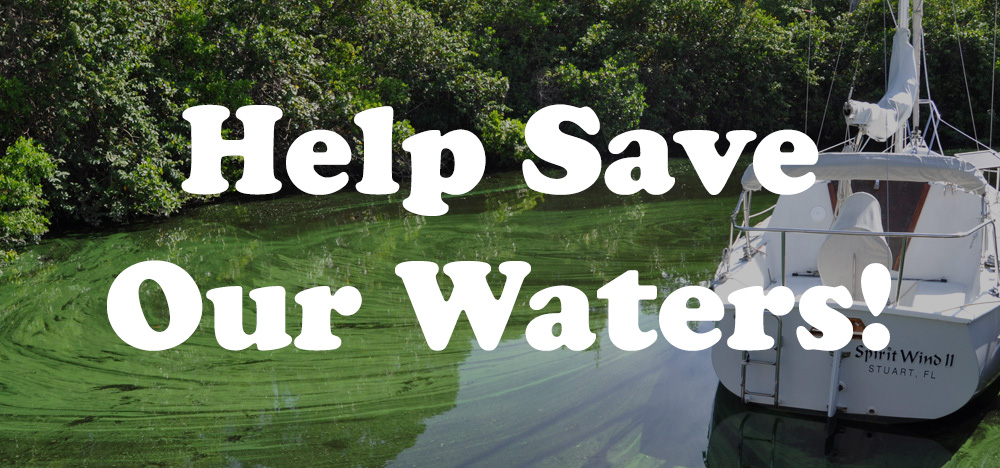Help Save Our Waters!

We need your help to provide community input on the Lake Okeechobee system operating manual (LOsom)
LOSOM is the operations plan that the U.S. Army Corps of Engineers (USACE) uses when they decide when and how much water is discharged from Lake Okeechobee. Last updated in 2008, LOSOM must be revised to address the following:
- Public Health
- Economic Impacts on our Coastal Communities
- Environmental Effects in our Estuaries
How can YOU help?
Put your comments/concerns in writing and send them to the USACE by April 22nd. (This will become part of the public record and the USACE is REQUIRED TO RESPOND!)
Submit comments by email:
Submit comments by mail:
Dr. Ann Hodgson
U.S. Army Corps of Engineers Jacksonville District P.O. Box 4970 Jacksonville, FL 32232-0019
Comment Suggestions:
Public health impact
- According to research by Dr. Brand of the University of Miami, exposure to toxic blue green algae found in discharges from Lake Okeechobee represents a major human health risk, ranging from gastrointestinal disorders to liver damage and death. It has even been implicated in Alzheimer’s, Parkinson’s and ALS. In the evaluation of the new LOSOM, the Corps needs to quantify the risk that Lake discharges containing toxic blue green algae pose to human health.
- The Corps has spent over a billion dollars reinforcing the Herbert Hoover Dike, thereby reducing the risk of harm to the people and farms south of Lake Okeechobee. It’s about time the Corps now focuses on reducing the human health risk in the communities around the estuaries by significantly reducing or eliminating discharges of toxic blue green algae to the estuaries.
- During the re-evaluation of the LOSOM, the Corps should evaluate one scenario that allows ZERO discharges to the estuaries when toxic blue green algae is present. Just one alternative that provides the greatest protection of the public health in the communities around the estuaries. Just one.
Economic impact
- Water-related businesses around the St. Lucie and Caloosahatchee Estuaries provide approximately 80,000 jobs and $3.8 billion per year to the economy of the State of Florida.
- Major Lake discharges harm our fishing and other water-related businesses. In the evaluation of the new LOSOM, the Corps needs to quantify the economic impact to our fishing and other water-related businesses.
- Major Lake discharges harm our restaurant, hotel and other tourist-related businesses. In the evaluation of the new LOSOM, the Corps needs to quantify the economic impact to our restaurant, hotel and other tourist-related businesses.
- Major Lake discharges adversely affect our property values and real estate sales. A Florida Realtors report in 2015 reported a loss of property values associated with large Lake discharge events at almost $1 billion per event in the communities around the St. Lucie Estuary and Caloosahatchee Estuary. In the evaluation of the new LOSOM, the Corps needs to quantify the economic impact to our property values and real estate sales.
Environmental impact
- Lake discharges have all but wiped out the seagrass beds in the St. Lucie Estuary and southern Indian River Lagoon. These seagrass beds provide many critical functions for our estuary, lagoon and ocean animals, from serving as a refuge for young fish and turtles, food source for turtles and other animals, as well as filtering out harmful pollutants. The Corps needs to quantify the amount of seagrass that will be harmed by Lake discharges.
- Our estuary is covered in black gooey muck, a result of decades of discharge of suspended sediment from Lake Okeechobee. This muck holds on to nutrients, pesticides and other pollutants. It smothers the few remaining areas of seagrass. The Corps should evaluate ways to capture the sediment from the Lake before it enters the estuary – e.g., construction of a sediment sump such as was installed at structure S-155 in Palm Beach County.
- The St. Lucie Estuary and Indian River Lagoon is home to thousands of fish and plant species, including roughly three dozen threatened and endangered species. The Corps needs to quantify the impacts of Lake discharges to these critical species.
- Every time the Corps makes extended discharges from Lake Okeechobee, the few remaining oyster beds that are left in the St. Lucie Estuary are almost wiped out. The Corps needs to quantify the number of oysters that will be harmed or killed by Lake discharges.
- Almost all the Lake water that enters the Everglades is treated in stormwater treatment areas, yet none of the Lake water that is dumped to the estuaries receives any treatment. The Corps should ensure that all Lake water to the estuaries is also treated.
